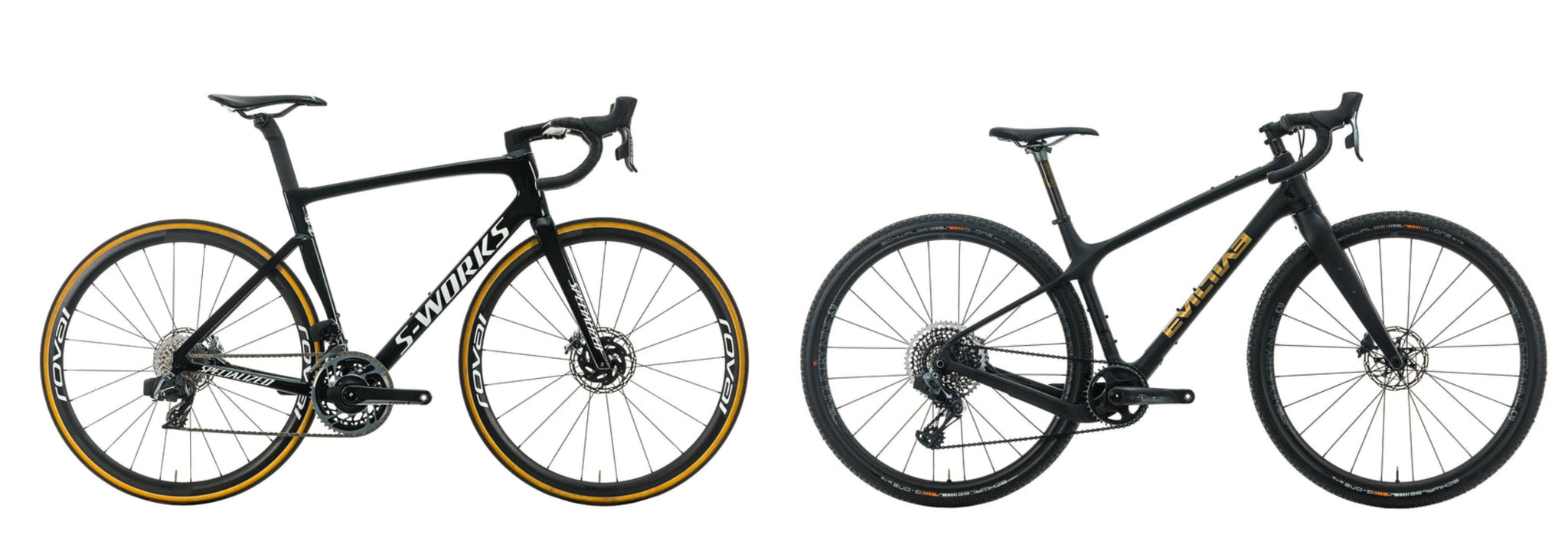To the uninitiated, road bikes and gravel bike look extremely similar. They share common characteristics, and in a lot of cases, you can use one bike for both disciplines. But if we’re placing bikes into categories, there are six key differences that make road bikes better for the road and gravel bikes better for gravel. This quick guide will explain these differences, so you can decide which bike is right for you.
[button]Shop Bikes[/button]
Road Bikes vs. Gravel Bikes: The Basic Differences

1. Road vs. gravel tires

- Road bike tires: Slick, 700c, 23-32mm wide
- Gravel bike tires: Slick, semi-slick, or knobby, 700c or 650b, 38-50mm wide
Because road bikes spend most of their time on smooth paved roads, road tires have a “slick” tread pattern, meaning there are no raised knobs. This minimizes rolling resistance for more speed and maximizes the amount of rubber contacting the road for accelerating, braking, and cornering. To save weight, road bikes use narrower tires and generally have much less tire clearance than gravel bikes. Road racing bikes usually fit tires in the 23-28mm range and endurance road bikes can fit tires that are 28-32mm wide.
[product-block handle="continental-grand-prix-5000-tire-700x25c-330tpi-clincher-black-2"/]
Gravel bikes, on the other hand, need to handle a wide range of surfaces, including pavement, but ultimately they have to excel on dirt and gravel. To venture off pavement, gravel bikes have substantially more tire clearance than road bikes and can fit wider gravel-specific tires that provide traction and comfort.
 Some gravel bikes are also available with 650b wheels and tires which use a smaller diameter wheel to fit even larger, high-volume tires for the roughest roads. Gravel tire treads range from slick to aggressive knobs to suit different riding conditions and they are tubeless-ready. Most gravel bikes come equipped with tubeless-ready wheels. Tubeless has only recently become more common on road bikes.
Some gravel bikes are also available with 650b wheels and tires which use a smaller diameter wheel to fit even larger, high-volume tires for the roughest roads. Gravel tire treads range from slick to aggressive knobs to suit different riding conditions and they are tubeless-ready. Most gravel bikes come equipped with tubeless-ready wheels. Tubeless has only recently become more common on road bikes.
[product-block handle="panaracer-gravelking-sk-tire-700x43c-126tpi-tubeless-black-brown-1"/]
Wide and knobby gravel tires are slower on pavement, but if needed, gravel bikes can always be set up with road tires too. Also, genre-bending endurance road and “all-road” bikes are emerging that can fit much wider tires than normal road bikes. A good example is the latest generation (2020+) Trek Domane, which can clear massive 38mm tires. Endurance road bikes are a great option for riders trying to split the difference between road and gravel.
[button]Shop road & gravel tires[/button]
2. Road vs. gravel gearing

- Road bike gearing: 2x chainrings, narrower range cassettes, higher top speeds
- Gravel bike gearing: 1x or 2x chainrings, wider range cassettes, easier low gears
Most road bikes use a drivetrain with two chainrings (2x). This provides ample gear range with a big outer chainring to achieve high top speeds and a smaller inner chainring to crawl up steep climbs. Because road riding is typically faster, road cassettes have a tighter gear range (11-28t to 11-34t cassettes are common) which provide more 1-tooth steps between gears. Smaller jumps between gears are desirable because it’s easier for riders to maintain a comfortable pedaling cadence at speed.
Gravel bikes can use either 1x or 2x drivetrains. Single-chainring drivetrain technology comes from mountain bikes, and some gravel riders prefer 1x because it’s simpler (you don’t need to think about shifting a front derailleur), and it provides better chain retention on rough roads. Most gravel riding is done at lower speeds on loose surfaces, so gravel bike gearing places a greater focus on easy gears. These “granny gears” are better for steep and loose gravel climbs or riding while loaded with bags and gear. 1x drivetrains have wide-range cassettes (10-42t to 10-52t cassettes are common) while 2x gravel drivetrains use smaller chainrings (46/30t and 48/31t chainrings are common) than standard road drivetrains.
[newsletter]
3. Road vs. gravel geometry

- Road bike geometry: Lower, more aerodynamic position, more agile handling
- Gravel bike geometry: Upright, more comfortable position, more stable handling
Many road bikes provide a lower (i.e., more bent over) riding position for better aerodynamics and a steeper head angle and shorter wheelbase for agile handling. Gravel bikes have a more upright riding position, a lower bottom bracket, slacker head angle, and longer wheelbase for more comfort and stability off-road.
Of course, these are generalizations; there are plenty of bikes that break from this. Among road bikes, endurance bikes are akin to gravel bikes with relaxed, upright positions and lower bottom brackets for more comfort and stability. Gravel race bikes like the Cervelo Aspero opt for more aggressive geometry to appeal to gravel riders who want to maximize aerodynamics, speed, and agility with a road bike-like riding position.
[button]Read More: How bike geometry works[/button]
4. Road vs. gravel comfort

- Road bikes: Greater focus on stiffness and efficiency
- Gravel bikes: Greater focus on compliance and comfort
Again, this is a generalization, but since gravel bikes are designed for gravel and dirt roads they prioritize comfort more to cope with rough roads. The biggest factor in comfort is tire size, and because gravel bikes use significantly wider tires that can be run at lower pressures, they’ll always feel plusher. Many gravel bikes also have extra compliance designed into the frame itself to mellow out bumps and vibration.
This doesn’t mean road bikes are uncomfortable. On regular paved roads, most road bikes are plenty comfortable, and the stiffer frames make them feel efficient and snappy. Once you venture off onto broken pavement, dirt, and gravel though, the limits of skinny tires and stiff frames become apparent. Roadies seeking to enhance their comfort should look to endurance bikes. They can fit wider tires, and popular models like the Specialized Roubaix and Trek Domane increase compliance with special shock-absorbing technologies added to the frames — the same technologies found on their respective gravel counterparts.
5. Road vs. gravel bike weight

- Road bike weight: Slightly less
- Gravel bike weight: Slightly more
Here’s another general statement: road bikes weigh less than comparable gravel bikes. Of course, super heavy road bikes and featherweight gravel bikes exist, so take note of the word “comparable.” Compare a road and gravel bike from the same manufacturer, with the same frame material, and comparable builds and the gravel bike is always heavier. There are a few factors that contribute to this, but the biggest difference comes from gravel bikes having larger tires and beefier frames. Don’t think too much about this though, because the weight difference is usually only a couple of pounds, and bike weight really isn’t that important.
6. Road vs. gravel components and accessories
 Road bikes use traditional drop handlebars, but in gravel, flared handlebars have become more popular. Flared bars angle the drops outward so they are wider than the tops of the bars. This provides comfort, stability, and control when riding in the drops off-road. Traditional road handlebars have less flare which can reduce the frontal profile of the rider and improve aerodynamics.
Road bikes use traditional drop handlebars, but in gravel, flared handlebars have become more popular. Flared bars angle the drops outward so they are wider than the tops of the bars. This provides comfort, stability, and control when riding in the drops off-road. Traditional road handlebars have less flare which can reduce the frontal profile of the rider and improve aerodynamics.
[button]Shop handlebars[/button]
Many modern gravel frames feature extra mounts on the frame to attach bags, racks, and fenders. Mounts on the top tube for top tube bags and mounts on the underside of the down tube for a third bottle cage are common on gravel bikes because good resupply stops are rare on backcountry gravel roads. Gravel bikes designed for commuting or bikepacking also have more space in the frame for frame bags, and extra mounts for bags and racks on the fork and rear triangle.
[button]Shop bags[/button]
 Suspension fork, dropper post, and room for bags? Yup, it's a gravel bike. Photo: John Watson.
Suspension fork, dropper post, and room for bags? Yup, it's a gravel bike. Photo: John Watson.
Some more extreme gravel bikes use mountain bike components to improve comfort and off-road performance. The most obvious is the gravel suspension fork. These lightweight, short-travel forks take the sting out of super rough roads and singletrack trails. Some gravel bikes also have internal routing to accept dropper posts, which lets riders quickly drop the saddle out of the way for technical off-road descents.
How to choose: Road vs. gravel bikes
Ultimately, there isn’t a hard line between road and gravel bikes. It’s more of a spectrum, and different road and gravel bikes are scattered throughout this spectrum. A lot of mountain bike technology has already trickled into gravel, and we’ll likely see more mountain bike tech like 1x drivetrains appear on future road bikes, further blurring the lines.
If you’re riding 100% on the road or on gravel, the choice is obvious. But if you’re reading this guide, it’s likely because you want to tackle different surfaces on the same bike. For riders struggling to decide, I have three basic suggestions:
- Choose the bike that excels at the riding that matters most to you
- Choose the bike that best compensates for your weaknesses
- Choose the bike that allows you to ride with more friends
My regular rides are about 75% road and 25% gravel. But I focus on gravel racing, need extra confidence for cornering on loose surfaces, and always feel beat up and sore after long rides. Plus, most of my cycling friends already ride gravel bikes. If I could only have one bike, I’d pick a comfy gravel bike. A road racer who dabbles in gravel would probably choose the opposite. I also think it’s easier to dress down a gravel bike for road riding than it is to beef up a road bike for gravel. Or you could do what I do and build a bike quiver with a road bike and a gravel bike
[button]Shop Bikes[/button]


















